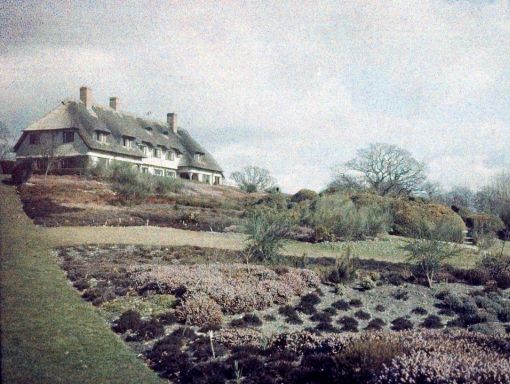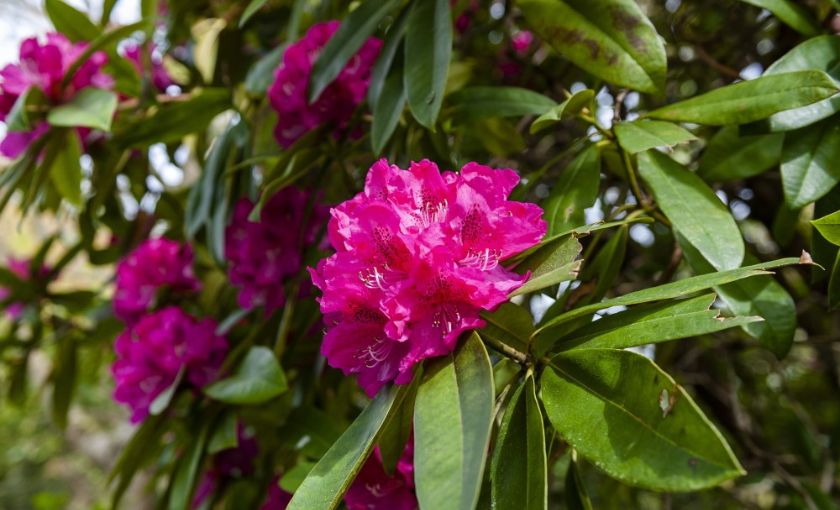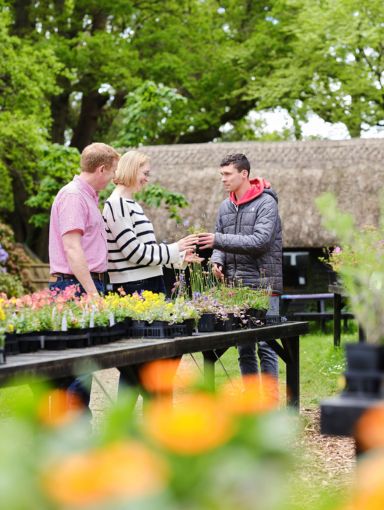A potted history of Furzey Gardens
Furzey Gardens has a fascinating history stretching back to the 1920s.
It begins in 1921, when land on the edge of Minstead in the New Forest was put for auction. The auction attracted interest from the Dalrymple family, an aristocratic military family from Scotland.
One of the family, a gentleman called Bay Dalrymple, bought the land which went onto become Furzey Gardens. His brother, Hew Dalrymple, established a plant nursery in Bartley near Minstead and the following year Bay bought extra land at Furzey.
This included the 16th century Furzey Cottage, believed to have been built in 1560 with boat timbers brought from Lymington. Furzey House, which is now a holiday let, was also built in 1922.

Early planting in Furzey Gardens
Both Bay and his brother Hew were keen plantsmen and Bartley Nursery became one of the most significant and respected nurseries in the gardening world in this period.
Furzey Gardens was first planted as a woodland garden on what had been open pasture land and over £7,000 was spent stripping out the rough gorse and bringing in good quality topsoil to cover the clay soil that the garden is know for. That was a very large amount of money in those days, about £300,000 in today’s money.
The origin of the name ‘Furzey’ is uncertain. It may have come from the old English name meaning gorse, which covered the area before the gardens were created, or more likely from James Furze, who was a professional charcoal burner who rented the small cottage in the mid-1800s for about 25 years.
We have good evidence of what was planted in the gardens and when, as one of the gardeners, Arthur Knowlton, was meticulous in his recording of the plants in the gardens together with the year of planting. These records are still held by the gardens, in a notebook known as ‘Arthur’s Book’. It is believed that Arthur was the original gardener when the gardens were first created and he was still there in the 1970s, so he had an absolute wealth of knowledge about the plants.
The planting of the garden initially started on the south slope nearest to Furzey House and consisted primarily of bulbs like narcissus, with some of these varieties still naturalised in the gardens today.
This was followed by planting a beautiful array of heathers and this Erica collection was added to over the next few years to give what must have been a magnificent and very extensive collection, we still have four of the little clay pots from which the seedlings were planted out.
Furzey Cottage became the head gardener’s cottage and at one time, there were 16 gardeners employed to manage and improve the gardens.
Shrubs and trees were introduced in to the gardens in the late 1920s and 1930s and the gardens were first opened to the public in 1930. They were filled with a vast array of different varieties, including camellias, rhododendrons and azaleas – these were not just specimen plants or common varieties, but what look like whole collections of varieties.
There were huge rockeries at Furzey Gardens in the 1930s, probably to grow the alpine plants listed in Arthur’s book. Much of the stone was apparently removed in the 1950s, but not all of it as the gardeners still find the rocks to this day when they are digging areas over. The variety of alpines grown here was immense and there were whole collections of some alpines such as Saxifrages, labelled with their Latin names with beautiful lead labels.
In fact, many of the original plants at Furzey Gardens were labelled with these tags made of lead, stamped with the Latin name of the plant. This was really lucky, as the lead has not deteriorated and many of these original plant labels have been found over the years by gardeners and still turn up to this day.
Many of the plants first grown in the gardens were supplied by Hew from the Bartley Nurseries. Apparently, Bay and Hew had friendly rivalry, Hew kept the best plants and gave the less robust plants to Bay!
There are several plants, some still within the garden which were propagated and named by the Dalrymples, for example Erica x darleyensis “Furzey”, one of the best winter flowering heathers, with an abundance of purple flowers in late winter near Furzey House and Primula pulverulenta “Bartley” – the beautiful candelabra primulas in shades of pink and rose in the damper areas of the garden, flowering in May.
In the 1920s and 30s there were plant hunting expeditions going on overseas to remote areas of India, Tibet and China and you can see that this would have been very interesting for a renowned plantsman such as Hew Dalrymple to find and develop species and varieties new to the UK.
According to the daughter of the Head Gardener at Bartley Nurseries, Hew, along with other local landowners such as Lionel de Rothschild from Exbury Gardens, helped sponsor two famous plant hunters of the early 20th century, George Forrest and Frank Kingdon-Ward.
New plants brought back from these plant hunting expeditions overseas would be named and catalogued by the plant hunter and we have been lucky enough to find several lead labels and entries in Arthur’s book with the Forrest and Kingdon Ward catalogue numbers, meaning that the plants were grown from the original seed or sample brought back from these expeditions.
These samples would have been grown on in Bartley Nurseries and some of the plants would have been sent to the gardens at Furzey.
We also know that some of these original plant specimens are still growing in the gardens, after almost a hundred years. There are going to be garden tours and information available in 2022 to give more information on 100 of the most interesting and historic shrubs, trees and flowers.
Arthur’s book illustrates that plant collections were added to up to 1939, but it is sad to see that there are no additions recorded from 1940 onwards until recent times. We do not know much about what happened when the second world war broke out, but it is likely that the gardeners were called up for service and the gardens became harder to maintain.
By the 1960s there was only one gardener left and the paths became overgrown and the brambles took hold. By 1972, the gardens were covered with weeds, brambles, saplings, unpruned shrubs and overgrown plants.
Subsequently, they were almost lost to provide land for new housing as the gardens were put up for auction in three lots with the intention of building another house on the site. Planning permission had been granted to demolish Furzey cottage.
Fortunately, Tim Selwood, our founder, wanted to do something interesting with the money left from his father’s estate and when he walked round the gardens in that April of 1972 he said that he was ‘carried away by the beauty of the place. The overgrown paths and extensive bramble patches could not hide the sights and scents of the flowering azaleas in the moist spring air’.
He was able to attend the auction as a very inexperienced 26 year old, and was successful in purchasing all three plots, which included Furzey House.
It then became necessary to find new people to look after the gardens. Having first appointed a head gardener, three 16 year old learning disabled school leavers were employed to assist him.
The family set up the Furzey Gardens Charitable Trust in 1973 and a few years later moved into a bungalow in Minstead to enable Furzey Gardens and house to be used solely for the benefit of the community in general and learning disabled people in particular.
One of the first tasks after acquiring Furzey was to obtain permission to build a gallery and tea room complex. The gallery was built in 1974 and the gardens were gradually restored over the following years and fresh discoveries are still being made nearly fifty years later!
In the 1990s, Pete White joined the team eventually taking over as Head Gardener. Over 30 years Pete developed the gardens, clearing overgrown areas and introducing a wide range of plants from many different countries. Many parts of the gardens have been developed, for example, a Board walk, tree houses, tiny fairy doors and a children’s play area have been introduced to add interest and the wildlife meadow was developed in 2014, where orchids and many other native plants have reappeared.
In 2012 the gardens entered the first show garden ever to be built by a learning disability team, at the RHS Chelsea Flower Show. Designed by Chris Beardshaw, it took two years of planning, fundraising and hard work, but won the Queen’s Diamond Jubilee RHS Gold Medal. Most of the plants were grown at Furzey, partly because of cost but also for authenticity. After the flower show, the garden was recreated at Furzey Gardens, near the lake area.
Today, people with learning disabilities are at the heart of the garden and given the opportunity to thrive. Head of Horticulture Andrew Bentley, leads a team of gardeners, volunteers and around 30 people with learning disabilities working hard to maintain the Gardens and bring on plants in the nursery.
History written by Julia Baker, Furzey Gardens volunteer, January 2022.
From its very beginning Furzey Gardens has been a pioneering place, full of rare or unusual plants gathered by intrepid plant hunters in its early decades. Its pioneering future continues today, as a place pioneering inclusion and support for people with learning disabilities. We look forward, with your help, to working over the next 100 years to help them become fully accepted and appreciated by their communities.



